Apr 20, 2024
Apr 20, 2024
by Saroj Thakur
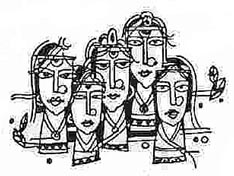 The Indian epics are replete with accounts of women much celebrated and revered in our culture. Most of these women find a place in the list of revered women by adhering to 'pativrata dharma', a virtue much sought after in the earlier times as it is even today.
The Indian epics are replete with accounts of women much celebrated and revered in our culture. Most of these women find a place in the list of revered women by adhering to 'pativrata dharma', a virtue much sought after in the earlier times as it is even today.
However, the shloka seems inexplicable by celebrating:
'Ahalya, Draupadi, Kunti, Tara and Mandodari tatha
Panchakanya smaranityam mahapataka nashaka'.
It seems like an aberration to the practice prevalent in the society as it records a very interesting deviation from the stereotyped image of the revered women of the epics and more so when we all know that these women were not only very much married women but strangely had 'known' more than one man in their life. In what way these women were extraordinary persons and why the chanting of their name could redeem a sinner (?) from transgression, were some of the questions that haunted us in even today in the twenty first century. Therefore, the National Seminar on the Pancha Kanyas was really a much-awaited event.
The five distinguished women of our epics the Mahabharata and the Ramayana invoked in this shloka of obscure origin seek our attention by being addressed as 'kanyas', an epithet used for maidens in Indian culture. Although the literal meaning of the word means a maiden but she has to be of within an age specified for 'kanyabhav.' However, more important is the connotative meaning of the word that generates emotions of reverence for a 'kanya' as she depicts everything that is pure in a 'being'. So, what was so pure in these women that would give them the epithet of 'kanyas'? The second important point to be analyzed in this shloka refers to the chanting of their names that redeems the sinners from transgression.
All the distinguished speakers made the best possible endeavor to make us understand this puzzle by elaborating some very exciting insights about these women, and if the shloka still remains mystifying for us, perhaps the fault lies in our inability to comprehend or the credit goes to the poet for writing a verse that would stimulate scholars to debate upon it even in the twenty first century!
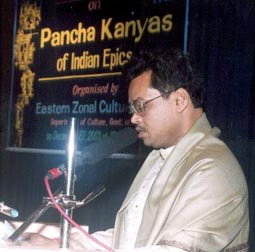 In fact, like most of the people present there, I was so enchanted by the kanya part of the shloka that mahapataka nashaka part did not register much on my understanding of the shloka. Had it not been for P. K. Mohanty, Director, EZCC, who in his welcome address stressed the mahapataka nashaka part of the shloka, I confess that I would not have even thought about it. As in common parlance, both the words ' papa and pataka stand for a common etymology. With commendable erudition, he brought to light the basic difference between these words and as per him, while papa stands for sin; so papanashinihwould mean redeemer of a sinner. It is as simple as committing a sin and then redeeming it by indulging in some way out. On the other hand, mahapataka nashakastands for stopping a man who is about to transgress but has not done so. It, therefore, acts as a checks and controls mechanism and a person stops short when he thinks of these five kanyas. Is it merely thinking about the after effect of what might happen that stops him, if yes, then how?
In fact, like most of the people present there, I was so enchanted by the kanya part of the shloka that mahapataka nashaka part did not register much on my understanding of the shloka. Had it not been for P. K. Mohanty, Director, EZCC, who in his welcome address stressed the mahapataka nashaka part of the shloka, I confess that I would not have even thought about it. As in common parlance, both the words ' papa and pataka stand for a common etymology. With commendable erudition, he brought to light the basic difference between these words and as per him, while papa stands for sin; so papanashinihwould mean redeemer of a sinner. It is as simple as committing a sin and then redeeming it by indulging in some way out. On the other hand, mahapataka nashakastands for stopping a man who is about to transgress but has not done so. It, therefore, acts as a checks and controls mechanism and a person stops short when he thinks of these five kanyas. Is it merely thinking about the after effect of what might happen that stops him, if yes, then how?
Therefore, it was in the very beginning of the seminar that a part so far lying dormant in my consciousness was suddenly awakened and awaited an elaborate discussion on this part of the shloka as well.
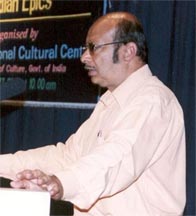 The overview of the seminar was given by Pradip Bhattacharya, who really needs no words to describe him. PB's various articles on the Pancha Kanyas had provided me a frame of reference to which I would be comparing all other speaker to and would become at times subjective in my approach to this critique. And just because all of these were so well researched and well presented that I could not find anything lacking in style or content, like an average fault finding person, I waited him to falter at least slightly when he spoke, to give me a chance to find him less than near perfect! However, his overview not only introduced the laypersons to the concept of Pancha Kanyas but also provided the much-needed humor to make us feel human and wait for an exciting session. In a lighter vein PB compared his job as the chairperson of the seminar to a 'Time-Keeper', but he acted like the Kala of the Mahabharata tele-serial, where he performed the tedious task of making the audience aware of certain facts that needed specialized references and would provide all explanations to the queries of the audience.
The overview of the seminar was given by Pradip Bhattacharya, who really needs no words to describe him. PB's various articles on the Pancha Kanyas had provided me a frame of reference to which I would be comparing all other speaker to and would become at times subjective in my approach to this critique. And just because all of these were so well researched and well presented that I could not find anything lacking in style or content, like an average fault finding person, I waited him to falter at least slightly when he spoke, to give me a chance to find him less than near perfect! However, his overview not only introduced the laypersons to the concept of Pancha Kanyas but also provided the much-needed humor to make us feel human and wait for an exciting session. In a lighter vein PB compared his job as the chairperson of the seminar to a 'Time-Keeper', but he acted like the Kala of the Mahabharata tele-serial, where he performed the tedious task of making the audience aware of certain facts that needed specialized references and would provide all explanations to the queries of the audience.
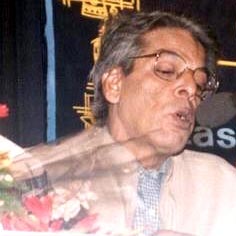 As the first speaker of the seminar, Dr. Nrisinha Prasad Bhaduri spoke at length on all the fivePancha Kanyas and it was a welcome step as the interest of the audience, generated by PB, was now heightened to know more about them. As the theme of his paper was 'Panchkanyas as Mahapatakanashini with special reference to Tara and Mandodari' and as he alone was a Sanskrit scholar and also because it was in the title of his paper to speak about why these kanyas were called as patakanashini, I was eager to find answers to queries aroused by Mohanty. However, the question nagging me about papa andpataka remained unanswered. Although dwelling at length on all the five kanyas, Dr. Bhaduri kept on mentioning these kanyas as papanashini although the shloka does not at all refer to such a word. As a scholar of Sanskrit literature, he was the best person to have answered the etymological connection between these words.
As the first speaker of the seminar, Dr. Nrisinha Prasad Bhaduri spoke at length on all the fivePancha Kanyas and it was a welcome step as the interest of the audience, generated by PB, was now heightened to know more about them. As the theme of his paper was 'Panchkanyas as Mahapatakanashini with special reference to Tara and Mandodari' and as he alone was a Sanskrit scholar and also because it was in the title of his paper to speak about why these kanyas were called as patakanashini, I was eager to find answers to queries aroused by Mohanty. However, the question nagging me about papa andpataka remained unanswered. Although dwelling at length on all the five kanyas, Dr. Bhaduri kept on mentioning these kanyas as papanashini although the shloka does not at all refer to such a word. As a scholar of Sanskrit literature, he was the best person to have answered the etymological connection between these words.
Dr.Bhaduri, however, through his brilliant discussion provided an explanation for placing these five women on a high pedestal. According to him addressing these women as redeemers of sin points to the fact that the tradition did not adhere to a conceited idea of chastity of women and aberration, although not much common, were accepted gracefully. Thus, the verse has shown a tint of liberalism in the traditional patriarchal society that could act as a message to the modern society that there could be alternative explanations and notions about chastity of women.
Another explanation that he comes with is based on the Vishnu cult according to which the most important and purifying event in the lives of these women is that each of them had met the godhead within their lifetime. However, this explanation does not seem substantial as he himself mentions later on that the savoir gods mainly Krishna and Rama liberated and redeemed people from bondage and sins. Then what could be so special about these women to find place in this celebrated shloka?
The views of Shri Anantlal Thakur, mentioned by Dr. Bhaduri throw light on another aspect of Kunti-her pativrat dharma. In the same light, Draupadi too finds an esteemed reverence because of her pativrata dharma and another revelation surprises us that all the Pandavas were in fact Indra's part, thus were one!
However, little explanation is given as to why Tara and Mandodari, the only two non-Aryan women in the list are mentioned. As the whole journey of Rama seems to have its origin in the aryanisation of the non-Aryans, through subjugation or assimilation, Tara and Mandodari being representatives of the major victory of such a scheme of things, find a mention in this shloka. The only common factor in both these women is their marriage to the younger brothers-in-law after the death of their husbands. Strangely, both Ravana and Sugriva are killed by Rama in connivance with their younger brothers. The wives of the deceased kings come as a token reward for the help they rendered to Rama for the purpose of assimilation and subjugation of these kingdoms.
Although Dr Nrisimha Prasad Bhaduri deliberated at length on the concept ofPanchkanyas yet stressing upon the word Papanashinis in the beginning of the paper instead of the word mahapataka nasinih, the whole line of thought presented in the paper went astray. It is the basic difference between what both these words mean that lies at the crux of understanding of the shloka for a clear interpretation. However, by the time Kunti's credentials as a Kanya are established, she is described as Patakanasini.
If we keep aside all these discussions on the use of an ambiguous terminology that gave a vague start to the paper, on the whole it served as a stimulator for the discussions in the seminar.
The discussion by Dr. Bhaduri, therefore, opened more queries than solving a few and herein lies the beauty of the paper as it enthused a thought process.
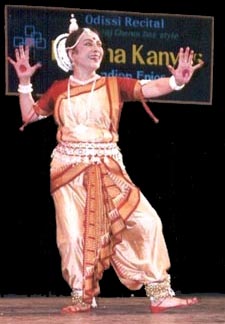 The portrayal of the Pancha Kanyas in the paper read by Dr. Ratna Roy in the morning session and her dance performance in the evening were both very helpful to understand the concept of Panchkanyas as understood by the Mahari Dance performers.
The portrayal of the Pancha Kanyas in the paper read by Dr. Ratna Roy in the morning session and her dance performance in the evening were both very helpful to understand the concept of Panchkanyas as understood by the Mahari Dance performers.
As she had explained in her paper, 'The Portrayal of Pancha kanyas in Guru Pankaj Charan Das' Odissi Dance Drama", that Mahari dance form is a unique blend of art and literature, we found it to be exactly so when all the Pancha Kanyas were depicted through Odissi Dance Drama in the evening. She has very rightly mentioned in her paper that the PanchaKanyadances - play with the connotation of the words - Sati,' 'Mahasati,' and 'Sattvika' as applied to women who were considered fallen by mainstream society.' It is really noteworthy that all the five maidens celebrated in the Panchakanya shloka led like Maharis whose lives are auspicious although they are supposedly impure. It is the similarity between these five maidens and the Maharis that is significant as it emphasizes the 'notion of being fallen' and 'virtuous' simultaneously.
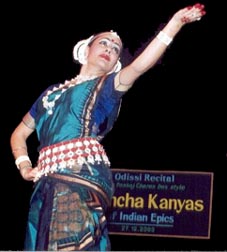 Scheherazaad Cooper, a student of Dr. Ratna Roy performing at the Seminar. |
The use of Oriya in the song accompanying the dance is a significant deviation from the accepted practice of using Sanskrit and thereby rejecting Sanskritic Tradition and embracing the Tantric philosophy of Mahari dance at the temple of Jagadamba.
Had Dr. Ratna Roy not read the paper before her performance, all these seemingly small but significant details would have gone unnoticed by viewers, like yours sincerely, not much conversant with this dance form!
Ratna Roy emphasized on meditating in the five Kanyas as they symbolize the five elements. The five elements are equated with the five Kanyas: Ahalya born of water, Draupadi born of fire, Kunti born of earth, Tara Born of wind and Mandodari born of ether.
Ahalya, a devoted wife who would wash her husband's feet everyday and drink the water, is cursed by her husband only because she was deceived by Indra who was infatuated with her beauty. In an informal talk before the performance, Ratna Roy talked about her feeling of repugnance, every time she had to enact the role of Ahalya drinking water in which she had washed her husband's feet and the subsequent treatment meted out to this Kanya by her husband, shook the very core of her being, as a woman.
This represents the practice of the patriarchal society where a woman is invariably condemned for no fault of hers, whereas, one really responsible for the heinous crime is not questioned at all. So very relevant to the reality of the Maharis' lives!
Draupadi pleads to all her husbands - all five of them - to save her from disgrace in the assembly. We all are conversant with this famous scene of the Mahabharata. In this dance, their heartlessness is stressed deviating from the epic story where they are bound by dharma, having been pledged and lost by the eldest brother. Draupadi lets herself go and stretches both her arms. The scene is depicted as the complete surrender of Draupadi at the feet of Krishna. Nevertheless, we find a pleasant change that unlike Ahalya, Draupadi questions and voices her fears but ultimately becomes vulnerable and pleads with Krishna.
Kunti, the next Kanya, is shown in the act of love making with Surya, the Sun God. The music and the movement to depict the birthing of Karna by maiden Kunti gives a realistic touch to the story. Her giving birth to three more sons, shown through dance, depicts her independence and ultimately her whole life serves as an example of the strength of a single mother raising five sons, is what makes her a real Kanya.
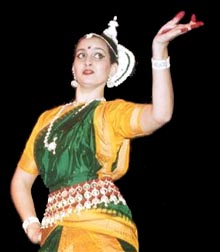 Sitara Thobani a student of Dr. Ratna Roy performing at the Seminar. |
It is Tara that held us captivated by her strength and potency of character depicted through her questioning and blaming an Aryan king Rama, the morality of killing Bali. Accusing Rama of deceit, Tara has the courage to ask him what difference does it make whether he kills a 'venire' or a 'nari', which when listened to seems like 'vanara-vanari' but was explained by Ratna Roy to be a monkey or a woman. Tara stresses that for a man killing a monkey or a woman is just one and the same thing. Women are thus equated with monkeys, a lesser human beings and was it not just what their social position referred to?
Mandodari, the last Kanya was depicted with relation to Ravana, her husband, in a soft shade. The love scene between Ravana and Mandodari, helped us to add a softer and mellower dimension to Ravana, whom as an abductor, we looked down upon.
Mandodari's unflinching love for her husband is brilliantly captured in this love scene. And even before we are to come out of this effect, we have Ravana prepared to go to war, that he knows to be his last, and Mandodari preparing to send her husband to this final war with the same gusto that she made love to him with. A real Kanya!
The depiction of Panchakanyas concept in this dance form brought all those feelings to be experienced visually that we had till now been with mentally. Draupadi's anguish and her prayer to Krishna during the sabha parva, Mandodari's love scene with Ravana and her sending him to the war were remarkable for their depiction. Tara's accusation and finally accepting Sugriva as her husband, Kunti's strength and Ahalya's penance are what moved all the audience as all these stressed upon those parts that only a sensitive composer and presenter can think of portraying.
An out of the world experience really!
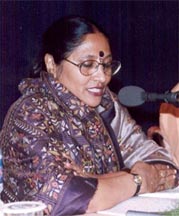 Saoli Mitra's paper on 'Draupadi in My Eyes' presented a mixture of emotive technique and a brilliantly explained text. Although, Draupadi's appeal to Krishna before he sets for a peace mission, is something that even the Mahabharatatext does justice to, but listening to the same as rendered by Saoli, seemed like an out of the world experience. Although Saoli preferred to speak on Draupadi as she saw her yet was successful in making us also see her from her point of view. I was moved by her performance of select scenes from the Mahabharata and the control that she effected in her rendering of the paper. A great artiste that she is, she would change track and read plane text of her paper when the audience were yet to come out of the effect of her emotive delivery, just concluded.
Saoli Mitra's paper on 'Draupadi in My Eyes' presented a mixture of emotive technique and a brilliantly explained text. Although, Draupadi's appeal to Krishna before he sets for a peace mission, is something that even the Mahabharatatext does justice to, but listening to the same as rendered by Saoli, seemed like an out of the world experience. Although Saoli preferred to speak on Draupadi as she saw her yet was successful in making us also see her from her point of view. I was moved by her performance of select scenes from the Mahabharata and the control that she effected in her rendering of the paper. A great artiste that she is, she would change track and read plane text of her paper when the audience were yet to come out of the effect of her emotive delivery, just concluded.
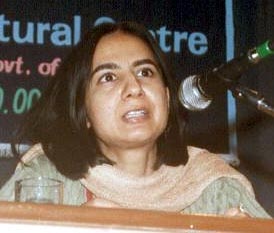 Archna Sahni's paper 'Draupadi as a Kanya: Unpeeling the Layers of Draupadi' seemed quite scholarly and therefore obscure for the audience. Had it contained simple ideas it would have been comprehended much easily by the audience. As the paper stressed on unpeeling the layers of Draupadi, by unpeeling the layers of meaning contained in 'kanya'.
Archna Sahni's paper 'Draupadi as a Kanya: Unpeeling the Layers of Draupadi' seemed quite scholarly and therefore obscure for the audience. Had it contained simple ideas it would have been comprehended much easily by the audience. As the paper stressed on unpeeling the layers of Draupadi, by unpeeling the layers of meaning contained in 'kanya'.
The first layer described the literal meaning of the word and Draupadi is considered to be akanya prior to her marriage as it meant a virgin or untouched by a man. However, all the women described in the shloka are married women and all have 'known' more than one man! From the above description, all of them could be called kanyas before being touched by a man.
The second layer, according to Archna, requires virginity as a virtue in the patriarchal society where it suited the male authority where 'a woman becomes a pawn in the world of masculine action where notions of purity and impurity are continuously modified to suit ends to be achieved.'
It is the third layer that says that requires a close reading as here she has questioned the veracity of all Panchkanyas including Draupadi, in the sense of a woman at One-in-herself or the autonomous being.
The reason ascribed by Archna as to why Draupadi cannot be called one-in-herself is that she is just a character dancing on the tunes of Vyasa and doing all that which is predestined. Here a new meaning is given to the word Panchali'doll' or 'puppet'. Except for a reference in Alf Hiltebeitel, I do not know of any such meaning and as this word is used in the Sabha parva where I think despite her being subjected to humiliation that would have broken any other woman in her place, Draupadi played the queen who by master stroke not only won freedom for herself but even for her mute and dumb husbands!
Do we need any other reference to show that she never was a puppet, as she knew even before she asked the question about her status that she was a free person?
It was only Draupadi who was one-in-herself and an autonomous being during the entire episode. All males in the sabha seemed to have lost their 'self'.
The notion that these women cannot be called 'autonomous beings' as they function 'squarely within the precincts of patriarchy, and do not challenge them in any way' does not seem much emphatic as Draupadi and Kunti do just the opposite. Both of them desire to be 'autonomous' even while bound by the patriarchal society and they achieve this desire by being psychologically independent.
If the shloka voices discomfort with the idea of a woman's sexual experience outside the institution of monogamy, why must it celebrate the memory of such women as redeemers of sin. I think that by celebrating such women, sexual experiences outside marriage have been accepted if the woman remains psychologically pure and untainted.
The dictum: 'Let us keep Draupadi in view, but let us learn from Amba.' would lead us nowhere. It seems that for Archna Sahni, women have to reject their female self to come up as a venerated one or the better one. Her Draupadi, in order to become aKanya has to cast aside her husbands and Amba that we are asked to learn from, renounces the world, to be born as a man to take revenge from Bhishma.
How can Amba adopt virgin condition by literally rejecting womanhood, passes my comprehension? As the real empowerment lies in fighting the established mores by retaining and respecting one's own gender and not by rejecting it as if it was something to be ashamed of for making you vulnerable to certain thing that can happen only to a woman.
Here I would like to stress that although Sanskrit is a dead end language and the literal meanings of the words in this language could neither change nor could expand, however, the connotative meanings could always have a freedom to take the form of the time when they are comprehended. When we talk of the word 'kanya' or for that matter 'sati', we immediately experience some feelings on the basis of terms of references that may be different for different people but common cultural roots limit us to a common frame of reference. It is in this context that the words kanya, sati, papnashini and pataknashini need to be understood.
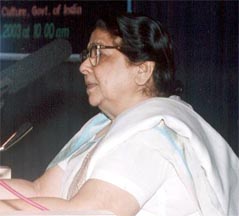 Dr Chitra Chaturvedi's paper on Kunti as a kanyawas refreshingly not only thought provoking but was also delivered in a manner befitting the context. Kunti, depicted as a virgin in the psychological sense, possessed those innate qualities that are not common among ordinary women. Chitraji is all praises to the unknown composer who has provided us the opportunity to judge a woman's worth from a parameter that is not bound by chastity or fidelity.
Dr Chitra Chaturvedi's paper on Kunti as a kanyawas refreshingly not only thought provoking but was also delivered in a manner befitting the context. Kunti, depicted as a virgin in the psychological sense, possessed those innate qualities that are not common among ordinary women. Chitraji is all praises to the unknown composer who has provided us the opportunity to judge a woman's worth from a parameter that is not bound by chastity or fidelity.
The qualities that make Kunti a kanya are the ones that any modern woman would just love to have. She is not dependent on any man, enjoys an identity of her own, devises original way to meet the challenge and the best of all is that although respecting social norms, she is not a slave to them and can override them if the need be. The story of her life from the beginning to the very end is an example of a woman one-in-herself, an autonomous being. Through out life she remains independent, strong and always akanya.
By equating Vidula's message sent by Kunti to her sons who were in a state of indecisiveness to fight or not to fight to a contemporary slogan given by Tilak 'Swaraj is my birth right and I will have it', she awakened the audience to find a reference that was a recent one. And by referring to Lal-Bal-Pal's Bengal connection, she was able to earn the heightened interest of the audience in Kunti's similar role in invoking her sons to fight for justice. Chitra Ji has provided a very exciting insight about Kunti through this stimulating paper and by making familiar and relevant references to the right of people to fight oppression, was really successful in driving home Kunti's leadership qualities and thereby depicting her as an autonomous being. The importance of Kunti role model even in the present world was what made thePanchakanya shloka relevant and worth debating upon. The best part of the paper was the style of delivering it. In fact, in paper readings, what you say has to be complemented by how you say it to be really effective. In Chitra Ji's it was an experience as even after she had finished, her words reverberated in the ears of the audience.
Smt. Pratibha Ray's paper 'Ahalya's Voyage: From Transgression to Transcendence' was read by Mohanty as because of some urgent assignment, she could not make it to the seminar. The paper was a well-written one as it raised questions about the use of myth and archetypes in Indian literature as an endeavor for returning to the roots of human existence.
Ahalya has been depicted as a dignified Vedic woman who could not indulge in such a sin as the mere touching of Indra would bring her to, except when she had some reasons behind such an act. This is the woman whom we can understand. Smt. Ray has stressed the need to analyse Ahalya's rise and fall from the viewpoint of psychology and sociology. Ahalya's moral fall cannot be called mere sensuality as human beings, both men and women, sink into sin for many complexes and compulsions. How true indeed! Was she not a woman with ordinary demands of the physical self and if she in a weak moment falls a prey to her bodily demands, what was so drastic about it. The different interpretations given about her conduct by the Vedic scholars provide insight into the basic nature of the persons giving these views. I myself find the interpretation of Ahalya as the 'uncultivated land' on which Indra rains and makes her fertile and fructified, quite convincing. Pratibha Ray's explanation based on the Valmiki's Ramayana supports this version. This interpretation seems authentic as in the early cantos of the Ramayana Valmiki depicts the Ahalya theme thus: possessed by sensual passion, Ahalya has surrendered herself to Indra consciously.
The Panchakanya shloka generates in all the women readers a conflict between physicality and morality, a basic question that sustained patriarchal hegemony in the society. Ray as a sensitive writer has very rightly tried to find an answer to this conflict and to analyze it further has to search for the meaning of the word Kanya. According to her analysis, Kanya is kamaniya 'if she adds glory to her by realization of self and the supreme power in her.'
How true indeed! If we again look at the shloka and analyze it now, one thing comes out very clearly that all the first three kanyas belonging to the Mahabharata had some common factors that they shared. All these three asserted themselves as a person by realization of self and the supreme power within them. All had sinned as per the standards prevalent in the society, Kunti by having an escapade with Surya during her maidenhood and later cohabiting with three others at the behest of her impotent husband. Draupadi by agreeing to a polyandrous marriage, a practice not heard of during the epic period. Knowing her temperament, that she revealed during her svayamvara where she stops Karna from aiming at the target, we at least know one thing for certain that had she not so desired, no one could have forced to this marriage.
Ahalya by wilfully entering into a short but beautiful relationship with Indra, to fulfil herself as a woman, depicts the independence of her character. The case of Ahalya, although represented in different manners in different sources, still retains a widely accepted truth that she had a short out of the marriage alliance with Indra. Ahalya possessed of sensual passion, surrenders herself to Indra and thereby asserts her right to happiness.
Although, the last two do not seem to have much to call them kanyas from this point of view but as they are there in the shloka, there would have been a very genuine reason for their being there. I think as the shloka is of obscure origin, the poet might have put them there only to redeem Rama of the sin whatsoever might have incurred on him for having killed Bali through treachery and Ravana through Vibhishana's help. This is just a possibility that can be although there is nothing to support it.
To conclude with, I think that why all these women were called kanyas finds a similarity in a way they asserted their independence. In case of Kunti, her earlier escapade with Durvasa/Sun and even later her summoning of three different gods to father her sons, speaks of one thing and that is her independence in the choice of sexual partners. Even Pandu, her husband, had been chosen by her in a svayamvaraand thereby asserting her freedom.
The case of Draupadi is even more interesting. Although she had known more than one man but all of them were her husbands. The fiery and independent Draupadi, who had the courage to question Karna's right to participate in the contest at hersvayamvara, chose to remain silent when a Brahman youth steps forward to try his luck. It shows that her silence has to be interpreted as acquiescence. Again when she is brought home and we have Kunti, unknowingly (?) passing the verdict 'to share it among all', we find Draupadi remaining silent. Whatever little we understand of Draupadi, at least one thing is certain that she would have objected had she so desired. Her silence and also part of a shloka might help us once again to interpret her silence as acquiescence.
'Then one by one
they glanced at Draupadi.
' Lovely Krsna looked at them.
They looked at each other.
It seems like a subtle and veiled hint of the poet to show her interest in this strange yet exciting polyandrous marriage otherwise could she not refuse such an arrangement!
Both these 'kanyas' asserted their right in the choice of matrimonial arrangements and later on using their right to self-determination decided not to have any more of children than they thought were permissible under dharma. By asserting their choice in procreation, these women display a high level of conscious power of creation and substantiate the fact that they were 'kanyas' as they enjoyed the realization of self and the supreme power within them.
Kunti and Draupadi, have thus become torch bearers for the contemporary women as embodiment of 'women's power' which is though pure and gentle, but firm and tenacious strength which these women have continuously displayed.
There are three stages commonly assigned to a woman's life: maiden, wife and mother and widow or sati. It seems that all patriarchal sources because of a woman's power to procreate were in awe of her and wanted to keep her in control. In order to instill a check, they created an environment for the feminine to be restricted and restrained. To treat women as outcastes during there menstrual cycle was a way to keep them away from the men folk as perhaps the sight of blood was a constant reminder to them about the inherent power of procreation that women enjoyed. And virginity as a requirement for marriage also was a way to ascertain that women do not transgress the restrictions imposed on them. After marriage, to control women's creative power, the concept of Pativrata is instilled in Indian womanhood and she is encouraged to accept service and devotion to a man as her ultimate religion and duty. What really seems pathetic is that their own needs and requirements take backstage!
But all these Kanyas were able to realize their own self and thereby use the power within for their own happiness and this is what makes them kanyas in the real sense.
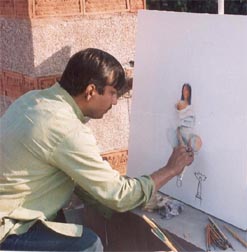 As was in the beginning, at the concluding session too, it was Pradip Bhattacharya who came up as the master of the show. With his usual brilliance, he concluded the seminar with references from such sources as Vimla Patil's article in The Tribune, a north Indian newspaper, to drive the relevance of the Panchakanya theme even in the present time. He cited many other contemporary references to find us for our own self the in which understanding these Kanyas would help us get answers to many questions that haunt us.
As was in the beginning, at the concluding session too, it was Pradip Bhattacharya who came up as the master of the show. With his usual brilliance, he concluded the seminar with references from such sources as Vimla Patil's article in The Tribune, a north Indian newspaper, to drive the relevance of the Panchakanya theme even in the present time. He cited many other contemporary references to find us for our own self the in which understanding these Kanyas would help us get answers to many questions that haunt us.
As if all this was not enough for us mortals to digest in a single day, EZCC had very wisely arranged an Artists' workshop and some eminent artists of Kolkata were busy giving shape to their imagination on canvas at Kalamandap, when all these literary discussions were going on! It was a treat to eyes to see various manifestations of the Panchakanyas drawn on canvas.
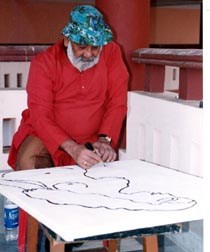 A lone figure of a woman sitting amidst wide expanse of space, painted in softer hues, made me feel the loneliness of all these Kanyas that they might have experienced in spite of being revered today by this shloka. Were they not lonely figures at heart!
A lone figure of a woman sitting amidst wide expanse of space, painted in softer hues, made me feel the loneliness of all these Kanyas that they might have experienced in spite of being revered today by this shloka. Were they not lonely figures at heart!
A black outline of Draupadi on stark white background, perhaps depicted the absence of colour Draupadi's life, although many a times she has been addressed as 'heroine of five Pandavas." However, did all these husbands add colour to her life or was she 'Krishnaa' a Black lady, who was instrumental in ushering us to Kali Yuga?
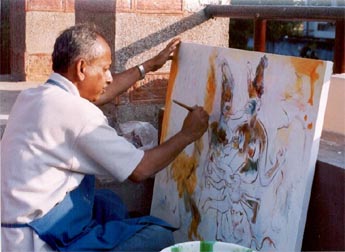 Another painting had so many hands attempting to grab a single female, again utter loneliness and vulnerability of women, was the focus. Although a distressing feeling but how real!
Another painting had so many hands attempting to grab a single female, again utter loneliness and vulnerability of women, was the focus. Although a distressing feeling but how real!
I honestly thank all those people who made this seminar a success as the real success of a seminar based on such obscure concepts lies in not coming to a conclusion but leaving the option open by generating interest of the scholars and the masses in issues that today are analysed openly. And herein lies the strength of a thinking society. Had Vyasa an opportunity to attend such a seminar he would have questioned the relevance of his shloka 'I raise my hands'.' as he would have realized that people do listen.
12-Aug-2001
More by : Saroj Thakur

|
Bali, and not Sugriv is killed by the other. Sugriv wins the Vanar kingdom back by slaying his brother with some help from Ram, and then accompanies Ram for the Lanka conquest. http://en.wikipedia.org/wiki/Sugriva Here is my take on the Panch Kanya's and what they stand for. http://windwatermind.blogspot.in/2013/03/the-panch-kanyas.html |

|
Kunti is not one of the Panchakanyas. It is surprising that Sita, Rama's wife, is missing from the Shloka. The Shloka as it is popular in the South India is: Ahalyaa Draupadi, Siita, Taaraa MaNDodari tatha | PanchakanyaaM smareen nityam, mahaapaataka naashanam || |